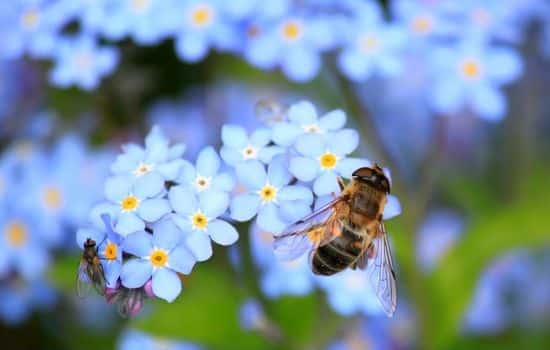Advertisements
Today's topic is bees and their importance, a relevant subject that everyone should know.
They are extremely important animals for the environment, as they are responsible for pollinating several species of plants.
Advertisements
They belong to the group of arthropods, the insect class and the order Hymenoptera.
In the hive, we observe the presence of the queen, the drone and the workers. They live in society and have a work organization.
Advertisements
SEE ALSO
THE FASCINATING WORLD OF SHARKS
WHAT YOU NEED TO KNOW BEFORE GETTING A GUINEA PIG
There are several species of bees in the world. There are currently a total of more than 20 thousand species.
See Also:
In this particular text I will talk a little more about Apis mellifera bees.
These are the best known, studied and also created throughout the world.
Characteristics of bees
These insects are from the phylum Arthropoda, inheriting some typical characteristics of this group: exoskeleton that covers their body.
In addition to having a body divided into three parts (head, thorax and abdomen), three pairs of legs, a pair of antennae and two pairs of wings.
Head
On their heads they have antennae connected to their sense of smell and hearing. Their eyes are compound and responsible for forming images.
The bees' mouthparts aid in the absorption of liquids and chewing.
The mandibles cut and manipulate the wax and propolis they produce, as well as helping with pollen ingestion and cleaning the hive.
Their tongue is known as a proboscis, which ensures the absorption of liquid substances.
Chest
In the thorax are the legs and wings, the locomotor organs of bees.
There are three pairs of legs, each pair on a segment, responsible for locomotion, transporting pollen, handling wax, propolis and cleaning their bodies.
There are two pairs of wings that allow the animal to fly. The front wings are larger than the back ones.
The thorax of bees has hairs that help to fix the pollen.
Abdomen
Most of the organs are found in the abdomen of bees.
Such as the honey gallbladder, which transforms nectar into honey; wax glands, which produce wax, stomach and intestine.
The stinger is located at the end, which serves for defense in the worker bee and as a guide in the queen during laying. The drone does not have one.
The stinger is connected to the venom sac, which releases a complex mixture of different substances called apitoxin.
How bees communicate
Bees live in society and communicate with each other. There are different ways for one bee to communicate with another.
Being through dances and the release of pheromones, chemical substances produced by them.
Dances are used to indicate the direction and distance of food.
Regarding pheromones, we mention the alarm pheromone, produced by workers, alerting other workers about the approach of an enemy.
The mandibular gland pheromone, produced by the queen: attracts drones for reproduction.
How the bee society works
When observing a beehive, we see that the individuals work cooperatively and there is a division into castes: queen, drone and worker.
The queen: the only female that reproduces in this society, and each hive only has one queen.
Fertilization occurs during the nuptial flight, a time when several drones can fertilize her.
Five days after fertilization, the queen lays eggs in the so-called combs, made by the workers.

The queen ensures reproduction and keeps all the bees inside the hive, achieving this thanks to the release of an aggregation pheromone.
Workers: also female, but they are not capable of reproducing. They perform different activities within the hive.
Such as feeding the queen and individuals in the larval stage, producing wax, collecting nectar, pollen and cleaning the site.
When a queen is missing, some workers can lay eggs, but they are not fertilized, resulting in only drones.
The Drone: the males in the hive have the function of ensuring the fertilization of the queen.
When fertilization occurs, the drones die due to the loss of their sexual organs during copulation.
It is important to highlight that each class presents some particularities with regard to its anatomy and morphology.
The queen is longer than the others, and the drone is larger. The workers are the smallest of the group.
The life cycle of bees
They go through metamorphosis and four stages of development: egg, larva, pupa and adult.
Queens are responsible for laying eggs: the first stage of bee development. The eggs are stored in the cells.
These will give rise to drones, deposited in larger alveoli than those that receive the eggs that will give rise to workers.
Bees can control the fertilization process. Fertilized eggs produce females and unfertilized eggs produce drones.
After the egg stage, a larva is born, which resembles a small caterpillar and is white in color.
This larva stays at the bottom of the alveolus, feeds and grows. After five molts, the larval phase ends.
Now it weaves a thin cocoon and begins the pupal phase, where the bee undergoes a complete metamorphosis.
Next, the bee breaks the lid of the cell, beginning the adult phase.
Bees and their importance
To the bees They have great ecological importance, fundamental for the reproduction of a wide variety of plants.
They are pollinating animals, that is, they ensure the transport of pollen from one plant to another, promoting the reproduction of the plant.
In addition, they are animals of great economic importance, raised for the purpose of producing various products, such as honey, propolis and royal jelly.
